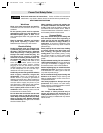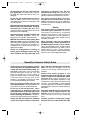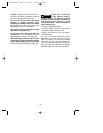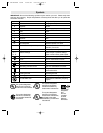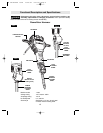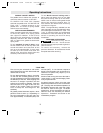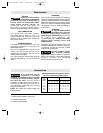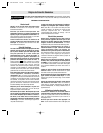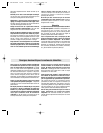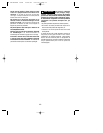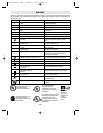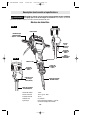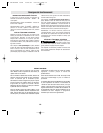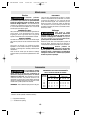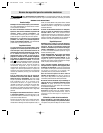
-3-
Do not force tool. Use the correct tool for
your application. The correct tool will do the
job better and safer at the rate for which it is
designed.
Do not use tool if switch does not turn it
“ON” or “OFF”. Any tool that cannot be
controlled with the switch is dangerous and
must be repaired.
Disconnect the plug from the power source
before making any adjustments, changing
accessories, or storing the tool. Such
preventive safety measures reduce the risk of
starting the tool accidentally.
Store idle tools out of reach of children and
other untrained persons. Tools are
dangerous in the hands of untrained users.
Maintain tools with care. Keep cutting tools
sharp and clean. Properly maintained tools,
with sharp cutting edges are less likely to bind
and are easier to control. Any alteration or
modification is a misuse and may result in a
dangerous condition.
Check for misalignment or binding of
moving parts, breakage of parts, and any
other condition that may affect the tools
operation. If damaged, have the tool
serviced before using. Many accidents are
caused by poorly maintained tools. Develop a
periodic maintenance schedule for your tool.
Use only accessories that are recom-
mended by the manufacturer for your
model. Accessories that may be suitable for
one tool, may become hazardous when used
on another tool.
Service
Tool service must be performed only by
qualified repair personnel. Service or
maintenance performed by unqualified
personnel could result in a risk of injury. For
example: internal wires may be misplaced or
pinched, safety guard return springs may be
improperly mounted.
When servicing a tool, use only identical
replacement parts. Follow instructions in
the Maintenance section of this manual.
Use of unauthorized parts or failure to follow
Maintenance Instructions may create a risk of
electric shock or injury. Certain cleaning
agents such as gasoline, carbon tetrachloride,
ammonia, etc. may damage plastic parts.
Demolition Hammer Safety Rules
Hold tools by insulated gripping surfaces
when performing an operation where the
cutting tool may contact hidden wiring or it
own cord. Contact with a "live" wire will make
exposed metal parts of the tool "live" and
shock the operator. Do not drill, fasten or
break into existing walls or other blind areas
where electrical wiring may exist. If this
situation is unavoidable, disconnect all fuses
or circuit breakers feeding this worksite.
Wear ear protectors when using the tool
for extended periods. Prolonged exposure to
high intensity noise can cause hearing loss.
Do not cut or drill into gas lines. Use a
metal detector to determine if there are
metal pipes hidden in the work area or call
the local utility company for assistance
before beginning the operation. Striking or
cutting into a gas line will result in explosion.
Always use the side handle for maximum
control over torque reaction or kick-back.
Never attempt to operate this tool with one
hand. The slip clutch engages if you firmly
control the tool during a torque reaction or
kickback.
Always wear safety goggles or eye
protection when using this tool. Use a dust
mask or respirator for applications which
generate dust. Safety goggles or eye
protection will help deflect fragments of the
material that may be thrown toward your face
and eyes. Dust generated or gases released
from the material you are cutting (i.e. asbestos
insulated pipes, radon) may cause respiratory
difficulties.
Use thick cushioned gloves and limit the
exposure time by taking frequent rest
periods. Vibration caused by hammer-drill
action may be harmful to your hands and
arms.
Position yourself to avoid being caught
between the tool or side handle and walls
BM 1619929522 12/02 12/10/02 3:43 PM Page 3




